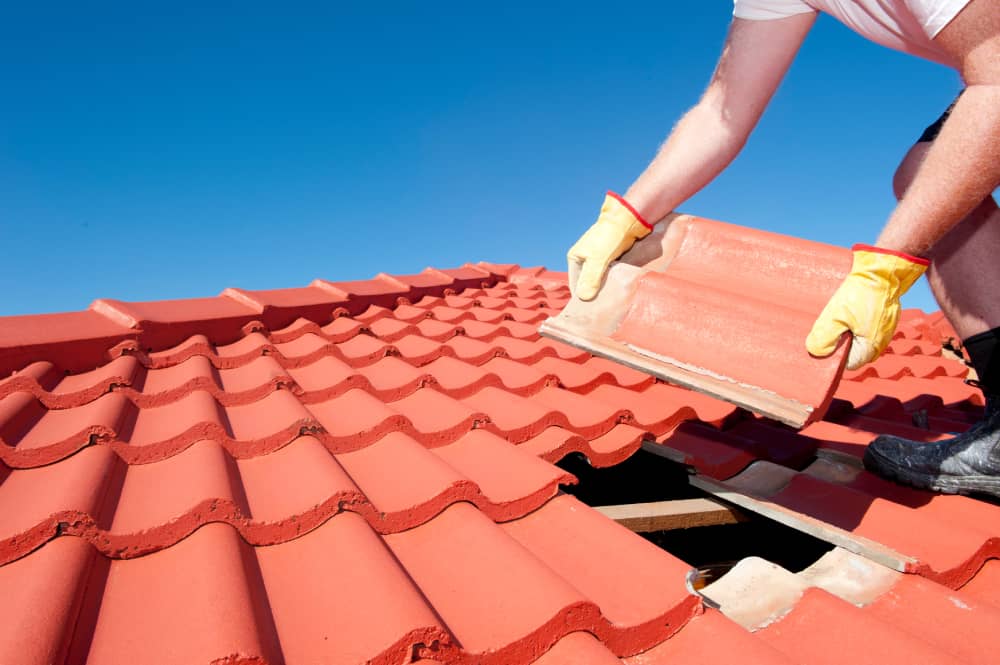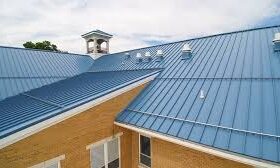What 2 states have the best year-round weather?
California and Hawaii of course!
However, the comfortable high temperatures that inspire beach days, can be detrimental to your roof.
You can’t control the weather but you can protect your roof from it. Harsh weather–like hail, heavy rain, and high winds–can cause damage to your roofing system. As a homeowner, it’s up to you to keep an eye on your property and make sure that everything is protected so that you have peace of mind at home. In this blog post, we’ll discuss how to weatherproof your roof with some easy tips!
Read on to learn how to protect your roof, the right way!
Inspect Your Roof
Before you start taking steps to prevent roof damage from weather, you’ll need to do an inspection. By understanding the current condition of your roofing system, you can decide whether or not you need to repair things. The last thing you want to do is weatherproof over a piece of damaged roofing material.
If you hide roof damage, water will have a way of finding its way inside. Once inside, rot and mold can happen, along with extensive water damage. Instead, you can save yourself a world of trouble by thoroughly inspecting every part of your roof, before doing anything else. That way you can start the weatherproofing process by repairing damage, and then taking the preventative measure.
Identify Roof Damage
What should you look for when you’re inspecting your roof. Identifying damage is a lot easier than you might think. Start by inspecting your roof drainage system. Next, look for any top layer materials that need replacing.
For instance, do you have shingles? Are they cracked or broken? If you have shingles, try to check to see if the shingles appear to be curling up at any point on your roof. Are any of them missing from spots in between where there should be a row of them? Another way to identify damage is by checking for any areas where the shingles are not laying level.
The last thing you want to do is walk on the roof like this because it could cause more damage and have an even bigger effect on your home’s integrity. If any of these things apply to you, call a professional right away for help, before any further damage can happen.
Replace or Repair Damaged Shingles?
Shingles are typically the first line of defense for your home. That is why it’s important to ensure that they’re in top shape at all times. One way you can do this is by swapping out old shingles with new ones when the time comes, or if not too much damage has been done then repairing them instead. Typically, asphalt shingles last around 15 years before you have to replace them.
How can you tell if a shingle is beyond repair? If there is water damage on the bottom of a damaged shingle with no nail holes in it then you should replace them all.
Weather Proofing Asphalt Shingles
You inspect your roof, replace and repair damaged materials, and now you’re ready to weatherproof. What’s the first step you should take? If you have an asphalt shingle roof, you can weatherproof the shingles by applying a granular material around the edges with an asphalt shingle rake. Be sure to also apply this sealant in other areas where water might leak through, such as downspouts and valleys.
Another way to weatherproof your shingles is by installing a soffit. A soffit stops most of the rain from coming in contact with your roof, while also adding to the curb appeal of any home.
In addition to these three options for weatherproofing asphalt shingles, there are products you can install on top and underneath them that will protect against water damage as well as other types of damages such as wind or hail storms. Most people should invest in an underlayment product like GAF Timberline Underlayment (which is one of the best). It protects both sides of your shingle material against moisture penetration which causes all sorts of problems – especially if it’s untreated wood!
Maintain Asphalt Shingles
Do you live somewhere with extreme weather conditions? Extreme temperatures can cause asphalt shingles to warp, and wear out, long before their time. Places that get hot or cold can make shingles brittle, and prone to cracking. time. To maintain a long-lasting roof, steps must be taken so that heat can’t get in. First and foremost, take off the snow as soon as it falls during winter or melts after spring has arrived.
The snow will trap heat from melting underneath it, which is detrimental for asphalt shingles because they are subjected to liquid water’s pressure at this point on their surface. Snow also makes them more susceptible to wind damage since the snow itself acts as an ice shield over the top of your roof when you live somewhere with extreme weather conditions. This protects the shingles from winds but traps any moisture underneath, which leads to rot and causes leaks inside your home if not properly cared for!
Inspecting Tile Roofs
So far, we’ve been talking about how to weatherproof by inspecting your asphalt shingles for damage. However, what if you have a tile roof? Should you follow the same process? Yes, you should follow the same steps to a tee.
Tile roofs are just as susceptible to wear and tear damage as asphalt shingles or metal tiles. As a result, it is important to know how and when to repair the damage.
A tile roof’s lifespan depends on many factors such as the type of tiles used in construction, materials that were manufactured during manufacturing or installation of the tiles, building location, and geological features. However, it’s important that before inspecting your tile roof material there are a few points of consideration.
For instance, how old is your roof? If you already know your roofing tiles are well past their due date, there’s no point in launching a big inspection. Instead, you can simply start the process of replacing the outdated roofing materials. In general, ceramic roofs last longer than asphalt shingles because they are more durable material due of their clay composition.
However, this does not mean that once you have a ceramic roof installed your worries about repairs will be over forever! The major cause for tile failure is hail storms but age also plays an important role in deterioration – replacing old tiles with new ones can help extend the life span of your home.
Did you know that tile roofs have been around for a long time? They date back to the Roman Empire. Tile roofs are still popular today because of their durability and beauty.
Weatherproof Clay Tiles
A clay tile roof is a beautiful way to protect your home from bad weather. These roofs can be installed on both residential and commercial properties, but they are often most common in the South because of their traditional architecture.
The benefits of this type of roof include its longevity and durability – it will last longer than other types of roofs. Additionally, it’s resistant to storm damage such as hail or wind-borne debris like leaves or twigs that could otherwise cause leaks if allowed into the house below through an uncovered gutter.
Moving on, tile roof systems should be checked annually for missing or broken tiles and any damage to the structure that could lead to leaks. This can usually be done by a person with some basic carpentry skills, but if you’re unsure about your ability in this area it might be best to contact a contractor.
A clay tile roof should always have an underlayment beneath it installed before the installation of the new tiles. Without this extra layer of protection from moisture on top, there is potential for cracks and water infiltration which may cause premature failure over time.
Finally, replace worn-out ridge caps as soon as possible so they don’t deteriorate further and create problems like leaking or wind damage. The type of metal used will depend on what’s been laid down.
Caring for Concrete Tile
Do you have concrete tiles on your roof? If yes, you can help prevent storm damage by taking the time to keep them clean.
A variety of methods exist for caring for concrete roof tiles, including pressure washing, applying a sealant coating, or brushing on products such as clear coat floor wax and mineral oil-based protectants. However, another option is to make your DIY kit that includes sandpaper sheets (with grits ranging from 240 through 800), water pa Ifint pens in black and white with an eraser pen tip built-in, silicone hand gloves, and paper towels).
Are you going to use a pressure washer on your concrete tiles?
If you’re pressed for time, a high-pressure cleaner is not the best thing to use on a concrete roof. You may be able to rent one, but it will take time and effort for you to get all the water out of the tiles’ crevices. This can lead to potential problems such as mold or algae growth in areas that are typically dryer than others during periods of heavy rain, which could mean your whole roof would need more frequent cleaning and maintenance if you continue using this method.
If you’re looking for an easier way, try using a ladder with squeegees instead of climbing up onto every section manually while scrubbing and rinsing away dirt from cracks between each tile’s joints.
Weatherproof Ceramic Roof Tiles
Last, but not least, let’s look at how you should maintain and weatherproof ceramic roof tiles. One of the best ways to keep damage at bay is by keeping your ceramic tiles squeaky clean! However, you’ll have to take steps to avoid staining or damaging the tiles during the cleaning process.
For instance, you’ll have to make sure you’re using the right detergents. You might want to use phosphate-free dish soap for washing your tiles. Phosphate-free detergents will help prevent too much residue from building up on tiles and causing discoloration. Dish soaps that contain bleach or ammonia are not recommended because they could corrode the ceramic tile’s surface.
Second, be careful when working with metal tools as these can scratch any glaze still present on your roof tiles. Third, don’t spray water all over them which may cause stains or even cracks in their surfaces if there is no protective coating applied beforehand.
When to Call Professional Cleaners
When should you clean your roof on your own, and when should you bring in the professionals?
One easy way to tell if your roof needs professional help from someone like Newroofplus.com is if there’s a noticeable increase in the amount of debris or algae on the roof. Your gut might also be telling you that something seems out of place, and this could indicate a problem with water runoff from your roof.
If you see any signs like these, call us for an inspection! You should never just go ahead and clean your roof without first assessing how damaged it is. Remember, roofs are made up of many different materials- some more delicate than others. Doing too much scrubbing can compromise the integrity of the roof. Professionals will be able to get inside valleys to remove dirt buildups using pressure washers or chemical cleaners.
When choosing a company to clean your roof, look for one with a stellar reputation. Using the right tools, professional roofers can seal up any holes or cracks in the structure and keep out moisture, which can cause mold to grow on the shingles. Caulking may be used instead for small jobs like sealing around window frames and other places where air might seep through.
What’s Better Asphalt or Tile?
Are you thinking about replacing your roof altogether? If yes, now could be the perfect opportunity to choose a new roofing material. Now that you know how to weatherproof tile and asphalt roofs, which one do you think you’d like the best?
Asphalt roofs have been popular for decades because they’re relatively inexpensive to install and easy to maintain; however, they typically don’t last as long as other options do. Clay and slate tiles tend to be more expensive upfront but also last longer than an asphalt coating would. There are many benefits and disadvantages of each type you should weigh when evaluating what compromises are right for your home.
Keep Your Roofing System Safe
As you can see, there are many roofing materials on the market today, each with its own maintenance needs. If there is anyone thing that will protect your investment in years to come it’s proper upkeep and weatherproofing.
Cleaning can be a hassle-free process if you have the right tools or call professionals who do this all day long! Pick a date you can have your roof cleaned today, and be sure to inspect for damage beforehand. By keeping your home free of debris, your roofing system can function at peak capacity! For more tips, read another article.












